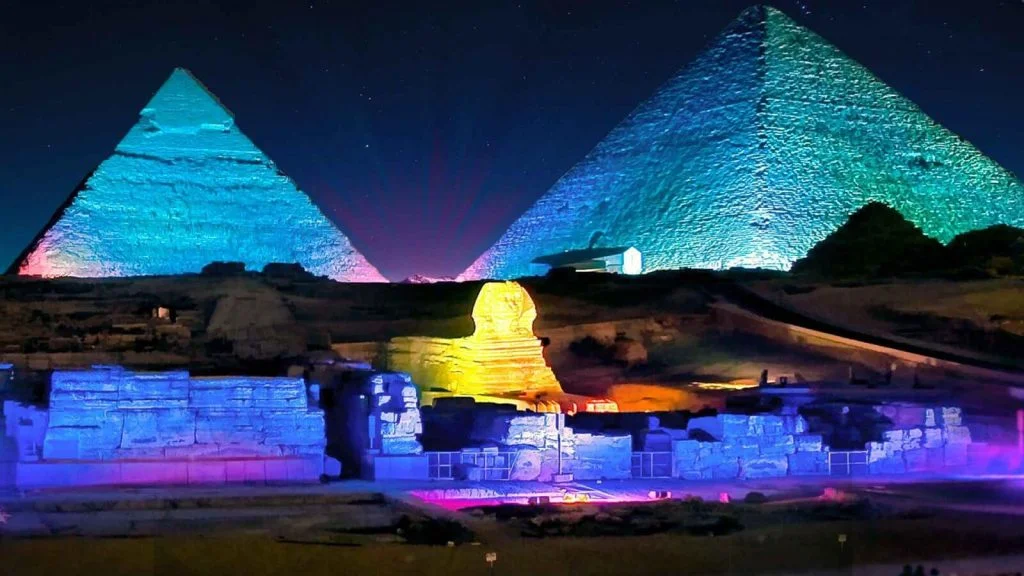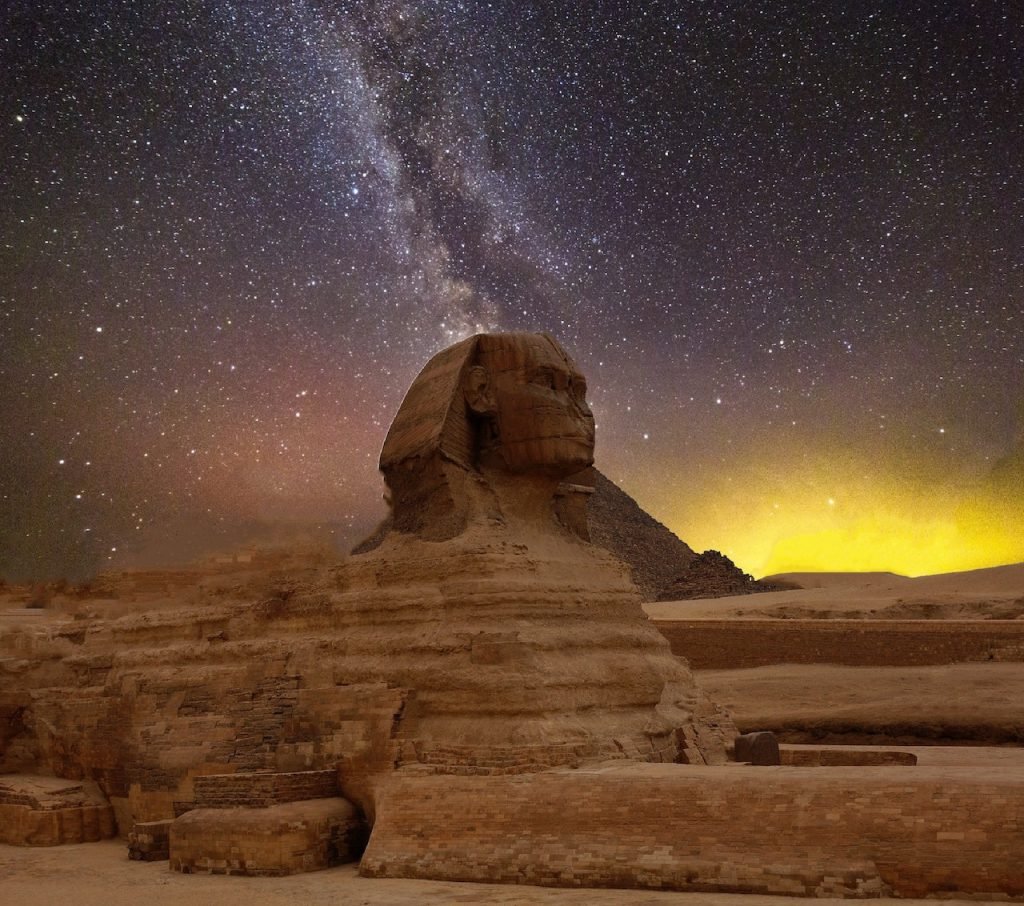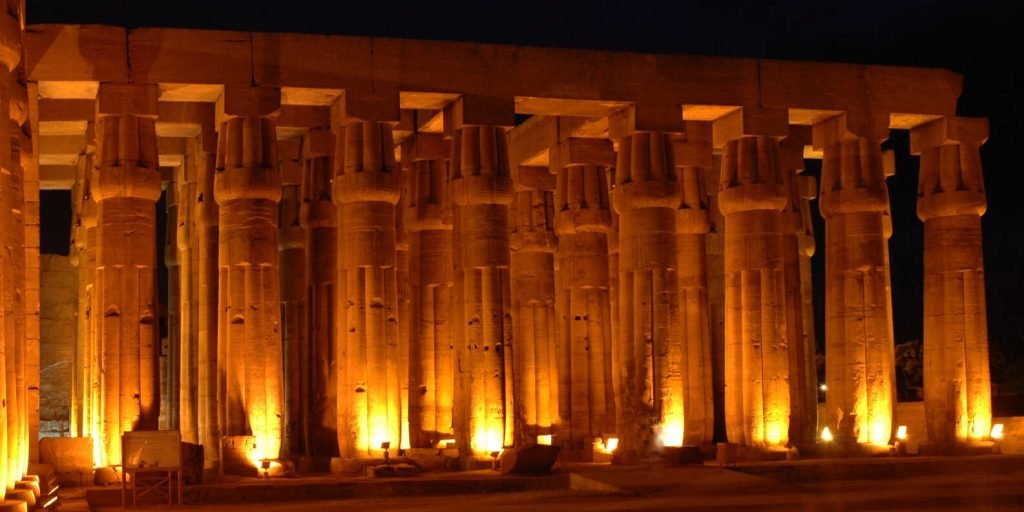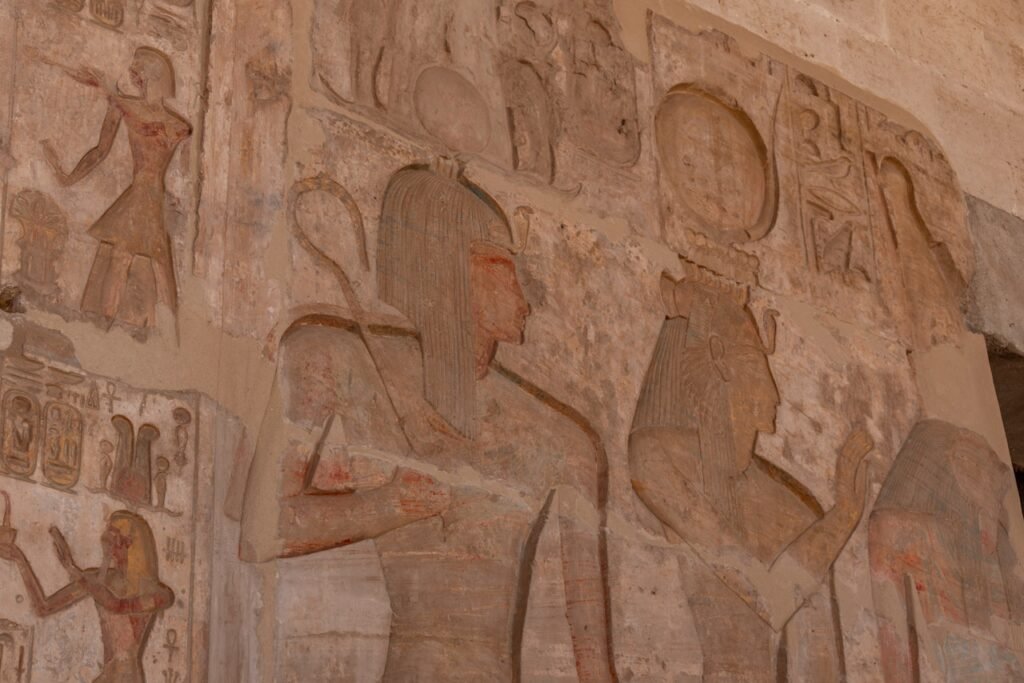Click here to Choose your Next Cheap Tour To Egypt The Price Starts From $25
The world has been captivated by the magnificent structures of Ancient Egypt for centuries. From the towering Great Pyramids to the enigmatic Sphinx, the temples of Karnak and Luxor, and the mystifying Hypogeum of Saqqara, these architectural wonders have baffled historians, archaeologists, and engineers alike. This article delves into the lost technologies of Ancient Egypt, uncovering the advanced engineering methods that enabled the construction of these iconic monuments.
The Great Pyramids: Beyond the Ordinary
Unlocking Pyramid Construction Technologies
The construction of the Great Pyramids at Giza remains one of the greatest enigmas in history. How were these colossal structures built with such precision, using rudimentary tools? Scholars have long been fascinated by this question and have proposed a variety of theories to explain how these ancient Egyptians managed to create such an impressive feat.
From stone cutting techniques and copper chisels, wooden levers and ramps, to pulleys for lifting heavy stones into place – all require remarkable engineering skills that are still admired today. We’ll explore the various theories behind this mysterious achievement as well as uncover more about their incredible engineering capabilities which enabled them to construct something so extraordinary out of basic materials.

The Precision of Pyramid Alignment
The alignment of the pyramids with the cardinal points and celestial bodies is an enigma that has puzzled scholars for centuries. Was this cosmic precision merely a symbolic gesture, or did it serve a practical purpose? In this article, we will explore the implications of this celestial connection and consider whether there was an astronomical purpose behind these alignments. We will also look at how ancient cultures may have used their knowledge of astronomy to build monuments that were in harmony with both earthly and heavenly cycles. By investigating these possibilities, we can gain further insight into our ancestors’ understanding of nature’s mysteries and marvels.
Read more: Unveiling the Top 10 Most Powerful Egyptian Gods | Ancient Egypt Deities
The Enigmatic Sphinx Technologies
Controversies Surrounding the Sphinx’s Origins
The Sphinx, with its unique combination of a lion’s body and a human head, has generated much debate over the years. Many believe it predates the accepted timeline of Ancient Egypt’s history and could point to an earlier civilization that is yet unknown. We will explore these debates surrounding its age, origin, and potential existence in more detail as we delve further into this fascinating topic.


Theories About Its Construction
The Sphinx is an iconic symbol of ancient Egypt, and the techniques used to carve and shape it remain a subject of fascination. Did the Egyptians possess advanced stone-cutting methods or tools that have since been lost to history? This question has intrigued archaeologists for centuries, with various theories proposed – including one suggesting water erosion was responsible. In this article we’ll explore these intriguing possibilities in greater detail, examining evidence from archaeological sites as well as modern research into ancient Egyptian engineering technology.
The Hypogeum of Saqqara: An Underground Marvel
Exploring the Intricate Tunnels and Chambers
The Hypogeum, located beneath the desert sands of Saqqara, is an awe-inspiring underground network of tunnels and chambers. We will explore its purpose and the remarkable engineering feat that was required to construct it. The challenges associated with this project were vast; from excavating deep into solid rock to creating a system for air circulation in such a confined space – all while maintaining structural integrity! It’s truly amazing how much effort went into constructing this ancient marvel and we look forward to uncovering more about its secrets as our exploration continues.
The Acoustic Properties of the Hypogeum
Its unique acoustics have sparked debate among archaeologists and historians, with some believing that it was intentionally designed for ritualistic or ceremonial purposes. We will explore this possibility by looking at the evidence available to us, such as its design features and potential uses throughout history. Additionally, we will consider how acoustic properties could be used in ceremonies or rituals of ancient civilizations to gain a better understanding of the possible purpose behind this mysterious structure.
The Temple of Karnak: Monumental Architecture
The Colossal Pillars and Their Precision
Karnak’s towering pillars are a testament to ancient engineering prowess, and it is remarkable how they were quarried, transported, and erected with such accuracy. The stones used in the columns were likely sourced from local limestone quarries that had been worked for centuries prior. Once cut into large blocks at the quarry site, these massive stones would have been transported by river barge or on land using wooden sleds pulled by teams of oxen before being carefully placed in their final positions. The precision with which each block was set speaks to an impressive level of skill among those involved in this monumental task.

Theories on How It Was Built
Researchers have proposed various methods for constructing the complex of Karnak, one of the most iconic structures in ancient Egypt. By examining these theories and their implications for ancient Egyptian technology, we can gain a better understanding of how such an impressive feat was accomplished. From analyzing archaeological evidence to utilizing modern engineering techniques, researchers are exploring different ways that this structure could have been built with tools and materials available at the time. The results from these studies provide invaluable insight into not only how it was constructed but also what kind of advanced knowledge may have been employed by its builders.
The Luxor Temple: A Nighttime Spectacle
Illumination Techniques Used in Ancient Times
The Luxor Temple is a stunning example of ancient Egyptian architecture, and its beauty shines even in darkness. The Egyptians used oil lamps to illuminate their temples, which were made from clay or stone and filled with animal fat. These lamps would have been placed throughout the temple complex to provide light for religious ceremonies. Lighting was an important part of many Egyptian rituals; it symbolized life-giving energy from the gods that connected worshippers to divine power.
Therefore, lighting was essential for performing these sacred rites within the temple walls and ensured that Egyptians could honor their deities in all manner of ways during nighttime hours as well as daytime ones.
The Significance of Astronomical Alignments
The alignments of Luxor Temple with celestial events have been studied extensively to determine whether or not they were deliberate. By exploring the connections between ancient Egyptian beliefs and their architectural choices, it is clear that many of these alignments were intentional. Ancient Egyptians believed in a cyclical view of time and saw the sun as an important symbol for rebirth and regeneration, which explains why so many temples are aligned with solstices or equinoxes.
This alignment also reflects their views on cosmic order and balance – something that was seen as essential for maintaining harmony in life. Thus, it appears likely that these alignments at Luxor Temple were indeed deliberate reflections of ancient Egyptian beliefs about cosmic order and renewal through the sun’s cycles
Obelisks: Monumental Monoliths
Crafting and Transportation of Obelisks
The creation of obelisks was a remarkable feat of engineering. Ancient Egyptians employed a variety of methods to carve these monumental monoliths, such as using copper chisels and hammers to cut the stone into shape. To move them into place, they used teams of workers and sleds drawn by oxen or other animals.
The massive stones were then either dragged on rollers or lifted with levers before being set in their final positions. This incredible feat required great skill and determination from the engineers who not only had to create but also transport these impressive monuments across vast distances for centuries without modern technology at their disposal.
Their Role in Ancient Egyptian Culture
Obelisks were an important part of Ancient Egyptian culture and religion. During ceremonies, obelisks served as a symbol of power and divinity, representing the presence of gods in temples or other sacred spaces. The symbolism behind these towering structures was also meaningful; they often represented the sun god Ra’s rays reaching down to earth, uniting heaven and earth together.
Additionally, obelisks could be used to commemorate Pharaohs’ victories in battle or celebrate their achievements during coronations. Ultimately, these monuments played a significant role in Ancient Egyptian society by conveying spiritual messages that unified people under one divine ruler – the Pharaoh – while celebrating his accomplishments at the same time.

The Puzzling Lake Moeris
The Artificial Lake’s Engineering
Lake Moeris, an ancient reservoir located in the Nile Valley, is a testament to the engineering and water management skills of its creators. It was created by Pharaoh Amenemhat III during his 12th Dynasty reign (1855-1808 BCE). The lake served multiple purposes such as providing irrigation for crops and fisheries for food sources. Its construction also helped control flooding along the Nile River by storing excess water during times of high flow. Lake Moeris serves as an example of how effective engineering and water management can be utilized to benefit local populations even thousands of years ago.
Theories About Its Purpose
The purpose of Lake Moeris has been a source of debate among scholars for centuries. Different theories have proposed that the lake was used for irrigation, flood control, and other purposes. In this analysis, we will evaluate these hypotheses and their implications for ancient Egyptian civilization. By examining the evidence presented by historians, archaeologists, and geographers alike we can gain insight into how this lake may have helped shape one of history’s most influential cultures in terms of its agricultural practices as well as its political landscape.
Hieroglyphs and the Rosetta Stone: Decoding Lost Knowledge
Hieroglyphic Writing as a Form of Technology
The intricate hieroglyphic writing system used by the ancient Egyptians was a remarkable feat of technology, and it has provided us with invaluable insight into their culture. It is believed to have evolved over time from an earlier form of picture-based writing called ‘hieratic’, which itself dates back to around 3200 BC. By combining symbols representing sounds, objects, or ideas together in various combinations, the hieroglyphs allowed for complex communication that could be understood by both literate and illiterate readers alike. Through these writings, we can gain a greater understanding of how the ancient Egyptians lived their lives – from religious beliefs and customs to everyday life activities such as farming or trade.
The Significance of the Rosetta Stone
The discovery of the Rosetta Stone in 1799 was a groundbreaking moment in history, as it gave scholars the opportunity to finally decipher ancient Egyptian hieroglyphs. The stone provided an invaluable key to unlocking this mysterious script, which had been largely undecipherable for centuries prior. It contained three scripts: Hieroglyphic, Demotic, and Greek – all versions of the same decree issued by King Ptolemy V Epiphanes in 196 BC. By comparing these different scripts against one another, scholars were able to identify specific symbols and their meanings within hieroglyphics for the first time ever – thus paving the way for a full understanding of ancient Egyptian culture and language that would not have been possible without this remarkable artifact.
The Unanswered Questions
Modern Attempts to Replicate Ancient Technologies
In recent times, engineers have been attempting to replicate ancient Egyptian techniques in order to gain a better understanding of their achievements. Through the use of modern technology and materials, we have gained insight into how Egyptians were able to construct such impressive monuments with limited resources. However, there are still many mysteries surrounding these ancient techniques that remain unsolved.
For example, it is unclear exactly what type of tools they used or how they managed to lift heavy stones without the help of cranes or other modern machinery. Additionally, some details about their building processes remain unknown as well as why certain design elements were chosen over others for particular structures and artifacts. Despite our efforts thus far in replicating these methods, however, much remains shrouded in mystery when it comes to the engineering feats achieved by Ancient Egyptians thousands of years ago
What We Still Don’t Know About These Technologies
Despite centuries of study, many aspects of ancient Egyptian technology remain shrouded in mystery. Archaeological finds and written records provide glimpses into the technological feats achieved by this advanced civilization, but much remains unknown.
For example, how were the massive stone structures like pyramids built? How did they develop their complex irrigation systems? What materials were used to create tools and weapons? These questions have yet to be answered definitively due to a lack of evidence or incomplete data. As we continue our research efforts it is likely that more information about these mysteries will come to light; however for now there are still persistent gaps in our knowledge when it comes to Ancient Egyptian technology.

Lost Technologies in Modern Times
Applications of Ancient Egyptian Knowledge Today
Believe it or not, ancient Egyptian technologies continue to have a profound influence on modern life. From the development of irrigation systems and water clocks to the use of papyrus for paper-making, many innovations developed by ancient Egyptians are still in use today. In addition, their architectural designs such as pyramids and obelisks remain iconic landmarks around the world.
Ancient Egyptian technology is also responsible for advances in mathematics including geometry which has been used to develop engineering projects from bridges to skyscrapers. It is clear that these innovative ideas developed thousands of years ago still serve as an inspiration for modern-day inventions and help shape our lives today.
The Importance of Preserving This Heritage
Preserving the lost technologies of Ancient Egypt is essential to ensure that this rich heritage is not forgotten. Not only do these artifacts provide invaluable insight into the past, but they also serve as a reminder of how far our civilization has come in terms of technological advancement. Furthermore, safeguarding these relics helps to protect them from further damage or destruction due to natural elements such as weathering and erosion over time. By preserving this important part of our history, we can continue to learn more about Ancient Egyptian culture and pass on their legacy for generations to come.
The Role of Mythology and Beliefs
Ancient Egyptian Beliefs and Their Impact on Technology
The profound influence of religion and mythology on ancient Egyptian technological advancements and architectural choices is undeniable. Ancient Egyptians believed that their gods were responsible for the success of their society, so they devoted significant resources to developing tools and structures that could honor them. This reverence for religious figures was reflected in many aspects of daily life, from the construction of massive temples to intricate irrigation systems designed to bring water into arid regions.
The use of hieroglyphics also served as a way to record stories about these deities while providing an efficient means for communication between leaders across vast distances. The legacy left behind by this culture continues today through its lasting contributions to architecture, engineering, artistry, and more—a testament to how deeply religion shaped ancient Egyptian progress throughout history.
Separating Fact from Legend
The study of ancient Egyptian technology is a complex and fascinating endeavor. With its roots in mythology, distinguishing between factual evidence and embellishments can be challenging. By sifting through the layers of mythological narrative, we can uncover core truths about the technological advancements made by this great civilization. Through careful analysis of archaeological discoveries such as tools, monuments, and artwork from various dynasties across Egypt’s long history we gain insight into how they developed their technologies to meet their everyday needs over thousands of years ago.
Rediscovering Lost Technologies
Ongoing Research and Archaeological Discoveries
Modern archaeology has revolutionized our understanding of Ancient Egypt and its lost technologies. Recent discoveries have revealed a wealth of new information about the advancements made by this ancient civilization, from their use of sophisticated engineering techniques to create monumental structures like the Great Pyramid at Giza to their development of complex irrigation systems that enabled them to cultivate crops in arid climates.
These findings provide us with an unprecedented view into life in Ancient Egypt, allowing us to gain insight into how they lived and worked thousands of years ago. Furthermore, these discoveries help shed light on the impressive level and sophistication achieved by this advanced society so long ago – all while reshaping our perception about what was possible for civilizations living during antiquity.
The Potential for New Revelations
As technology advances, our ability to study ancient artifacts and structures also improves. This opens up exciting possibilities for unlocking more secrets of ancient Egypt. For example, we may be able to use sophisticated imaging techniques such as 3D scanning or aerial photography to gain a better understanding of the layout and structure of archaeological sites like pyramids or temples.
We could also analyze genetic material from mummies in order to identify their family lineage and learn more about the individuals who lived during this period in history. Ultimately, these advancements will help us uncover new information about how people lived thousands of years ago that would otherwise remain hidden forever!
The Global Influence of Egyptian Engineering
How Ancient Egyptian Technology Influenced Other Civilizations
The ancient Egyptians were renowned for their engineering prowess, which extended far beyond the Nile Valley. Their innovations in architecture, irrigation systems, and mathematics had a significant impact on other cultures and civilizations throughout history. For example, they developed one of the earliest forms of writing called hieroglyphics which was adopted by many other cultures in later centuries.
They also created advanced tools such as levers and pulleys to help with construction projects that were later used by Greeks and Romans during their own building endeavors. The brilliance of Egyptian engineering has left an indelible mark on our world today – from modern-day mathematics to architectural marvels like the Pyramids of Giza – proving its lasting influence over time.

A Look at Similar Structures Worldwide
The ancient Egyptians were renowned for their engineering prowess, constructing impressive monuments and structures that still stand today. But are there parallels between the Egyptian structures and those found in other parts of the world? Through our investigation into global connections of ancient engineering, we can uncover some interesting similarities.
For example, early pyramids found in Egypt have striking resemblances to those constructed by civilizations such as the Mayans or Incas in Central America or Africa’s Nubian culture respectively. Moreover, many cultures throughout history have used similar techniques when building walls around cities; a practice that originated with fortification designs from Ancient Egypt during its Old Kingdom period (c2686-2181 BCE). It is clear then that while certain aspects may vary depending on regionally specific materials and construction methods employed at various points in time; much of what makes up modern architecture has roots firmly set within Ancient Egyptian practices.
Conclusion Lost Technologies of Ancient Egypt
In this exploration of the lost technologies of Ancient Egypt, we’ve ventured deep into the heart of a civilization that left behind a legacy of remarkable achievements. From the awe-inspiring Great Pyramids to the enigmatic Sphinx, and the grandeur of Karnak and Luxor temples, we’ve uncovered the genius of ancient Egyptian engineering.
While many mysteries remain unsolved, the dedication of modern researchers and engineers has shed light on some of these enigmas. The lost technologies of Ancient Egypt continue to captivate our imaginations and inspire us to delve further into the past.
FAQs (Frequently Asked Questions)
1. How were the Great Pyramids of Egypt constructed?
The construction of the Great Pyramids involved an ingenious combination of labor, engineering, and precise alignment with celestial bodies. While the exact methods remain debated, theories suggest the use of ramps, skilled labor, and advanced measurement techniques.
2. What is the significance of the alignment of the pyramids with celestial bodies?
The alignment of the pyramids, especially the Great Pyramid, with celestial bodies such as Orion’s Belt, has sparked theories about the ancient Egyptians’ astronomical knowledge and spiritual beliefs. It may have represented a link between the earthly and divine realms.
3. How old is the Sphinx, and who built it?
The age and origin of the Sphinx are subjects of controversy. While mainstream archaeology places its construction during the reign of Pharaoh Khafre, some alternative theories propose an older age and suggest it might predate the commonly accepted timeline of Ancient Egypt’s history.
4. What was the purpose of the Hypogeum of Saqqara?
The purpose of the Hypogeum of Saqqara is still a subject of research and debate. Some believe it served as a burial chamber, while others propose it had ritualistic or acoustic properties due to its unique design.
5. How did ancient Egyptians transport and erect obelisks?
Transporting and erecting obelisks required precise engineering and manpower. Large obelisks were carved at quarries and transported using sleds, rollers, and lubrication. Once at their destination, they were erected using a combination of levers, counterweights, and manpower.
This article has explored the wonders of Ancient Egypt’s lost technologies, revealing the incredible feats of engineering that continue to intrigue and inspire us today.

